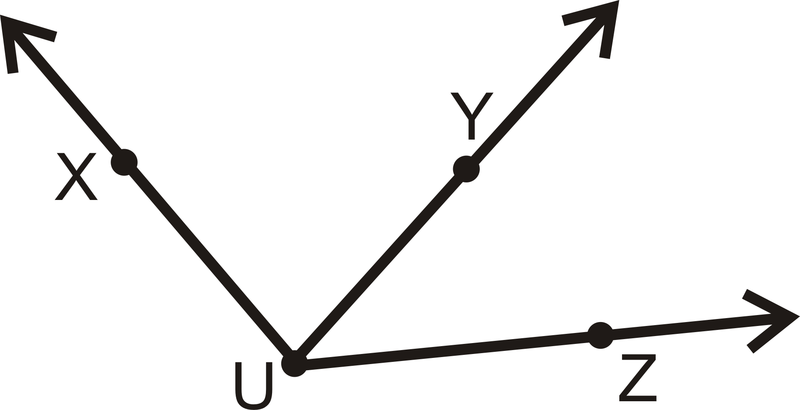1.9: Вимірювання кутів
- Page ID
- 54993
Вимірювання кутів за допомогою транспортирів та постулат додавання кута.
Кути
Кут утворюється, коли два промені мають однакову кінцеву точку. Вершина є загальною кінцевою точкою двох променів, які утворюють кут. Сторони - це два промені, які утворюють кут.
 Малюнок\(\PageIndex{1}\)
Малюнок\(\PageIndex{1}\)| Позначте це | Скажи це |
|---|---|
| \(\angle ABC\) | Кут\(ABC\) |
| \(\angle CBA\) | Кут\(CBA\) |
Вершина є,\(B\) а сторони -\(\overrightarrow{BA}\) і\(\overrightarrow{BC}\). Завжди використовуйте три літери, щоб назвати кут,\(\angle\) SIDE-VERTEX-SIDE.
Кути вимірюються чимось, званим транспортиром. Транспортир - це вимірювальний прилад, який вимірює, наскільки «відкритий» кут. Кути вимірюються в градусах і маркуються\( ^{\circ}\) символом. Наразі кути завжди позитивні.
 Малюнок\(\PageIndex{2}\)
Малюнок\(\PageIndex{2}\)Є два набори вимірювань, один починається зліва, а інший з правого боку транспортира. Обидва йдуть навколо від\( 0 ^{\circ}\) до\(180 ^{\circ}\). При вимірюванні кутів можна вирівняти одну сторону з\( 0 ^{\circ}\), і подивитися, де інша сторона потрапляє на транспортир. Вершина лінії вгору посередині лінії низу.
 Малюнок\(\PageIndex{3}\)
Малюнок\(\PageIndex{3}\)Зверніть увагу, що якщо ви не вирівнюєте одну сторону з\( 0 ^{\circ}\), міра кута буде різницею градусів, де сторони кута перетинаються з транспортиром.
Іноді вам захочеться намалювати кут, який є певною кількістю градусів. Виконайте наведені нижче дії, щоб намалювати\( 50 ^{\circ}\) кут за допомогою транспортира:
- Почніть з малювання горизонтальної лінії по всій сторінці, довжиною 2 дюйма.
 Малюнок\(\PageIndex{4}\)
Малюнок\(\PageIndex{4}\)- Помістіть кінцеву точку в лівій частині лінії.
- Помістіть транспортир на цю точку, таким чином, щоб лінія проходила через\( 0 ^{\circ}\) мітку на транспортирі, а кінцева точка виявилася в центрі. Відзначте\( 50 ^{\circ}\) на відповідній шкалі.
 \(\Індекс сторінки малюнка {5}\)
\(\Індекс сторінки малюнка {5}\)- Зніміть транспортир і з'єднайте вершину і\(50 ^{\circ}\) mark.
 Figure \(\PageIndex{6}\)
Figure \(\PageIndex{6}\)This process can be used to draw any angle between \(0 ^{\circ}\) and \(180 ^{\circ}\).
When two smaller angles form to make a larger angle, the sum of the measures of the smaller angles will equal the measure of the larger angle. This is called the Angle Addition Postulate. So, if B is on the interior of \(\angle ADC\), then
\(\angle ADC = m \angle ADB + \angle BDC\)
 Figure \(\PageIndex{7}\)
Figure \(\PageIndex{7}\)Example \(\PageIndex{1}\)
How many angles are in the picture below? Label each one.
 Figure \(\PageIndex{8}\)
Figure \(\PageIndex{8}\)Solution
There are three angles with vertex \(U\). It might be easier to see them all if we separate them.
 Figure \(\PageIndex{9}\)
Figure \(\PageIndex{9}\)So, the three angles can be labeled, ( \(\angle XUY\) or \(\angle YUX\)), \(\angle YUZ\) (or \(\angle ZUY\)), and \(\angle XUZ\) (or \(\angle ZUX\)).
Example \(\PageIndex{2}\)
Measure the three angles from Example 1, using a protractor.
 Figure \(\PageIndex{10}\)
Figure \(\PageIndex{10}\)Solution
Just like in Example 1, it might be easier to measure these three angles if we separate them.
 Figure \(\PageIndex{11}\)
Figure \(\PageIndex{11}\)With measurement, we put an m in front of the \(\angle\) sign to indicate measure. So, \(m \angle XUY = 84^{\circ}\), \(m \angle YUZ = 42^{\circ}\) and \(m \angle XUZ = 126^{\circ}\).
Example \(\PageIndex{3}\)
What is the measure of the angle shown below?
 Figure \(\PageIndex{12}\)
Figure \(\PageIndex{12}\)Solution
This angle is not lined up with 0∘, so use subtraction to find its measure. It does not matter which scale you use, as long as you are consistent.
Inner scale: \(140^{\circ} - 15 ^{\circ} = 125 ^{\circ}\)
Outer scale: \(165^{\circ} - 40 ^{\circ} = 125 ^{\circ}\)
Example \(\PageIndex{4}\)
Use a protractor to measure \(\angle RST\) below.
 Figure \(\PageIndex{13}\)
Figure \(\PageIndex{13}\)Solution
Lining up one side with \(0 ^{\circ}\) on the protractor, the other side hits \(100 ^{\circ}\).
Example \(\PageIndex{5}\)
What is \(m \angle QRT\) in the diagram below?
 Figure \(\PageIndex{14}\)
Figure \(\PageIndex{14}\)Solution
Using the Angle Addition Postulate, \(m\angle QRT = 15^{\circ}+30^{\circ}=45^{\circ}\).
Review
1. What is \(m \angle LMN\) if \(m \angle LMO = 85^{\circ}\) and \(m \angle NMO = 53^{\circ}\)?
 Figure \(\PageIndex{15}\)
Figure \(\PageIndex{15}\)2. If \(m \angle ABD = 100^{\circ}\), find \(x\).
 Figure \(\PageIndex{16}\)
Figure \(\PageIndex{16}\)For questions 3-6, determine if the statement is true or false.
- For an angle \(\angle ABC\),\(C\) is the vertex.
- For an angle \(\angle ABC\), \(\overline{AB}\) and \(\overline{BC}\) are the sides.
- The \(m\) in front of \(m \angle ABC\) means measure.
- The Angle Addition Postulate says that an angle is equal to the sum of the smaller angles around it.
For 7-12, draw the angle with the given degree, using a protractor and a ruler.
- \(55 ^{\circ}\)
- \(92 ^{\circ}\)
- \(178 ^{\circ}\)
- \(5 ^{\circ}\)
- \(120 ^{\circ}\)
- \(73 ^{\circ}\)
For 13-16, use a protractor to determine the measure of each angle.
-
 Figure \(\PageIndex{17}\)
Figure \(\PageIndex{17}\) -
 Figure \(\PageIndex{18}\)
Figure \(\PageIndex{18}\) -
 Figure \(\PageIndex{19}\)
Figure \(\PageIndex{19}\) -
 Figure \(\PageIndex{20}\)
Figure \(\PageIndex{20}\)
Solve for \(x\).
- \(m \angle ADC = 56^{\circ}\)
 Figure \(\PageIndex{21}\)
Figure \(\PageIndex{21}\)Review (Answers)
To see the Review answers, open this PDF file and look for section 1.5.
Vocabulary
| Term | Definition |
|---|---|
| Angle | A geometric figure formed by two rays that connect at a single point or vertex. |
| Protractor | A protractor is a tool used to measure an angle in terms of degrees. |
| Vertex | A vertex is a point of intersection of the lines or rays that form an angle. |
Additional Resource
Interactive Element
Video: Angle Basics
Activities: Angle Measurement Discussion Questions
Study Aids: Angles Study Guide
Practice: Measuring Angles
Real World: Angle Measurement